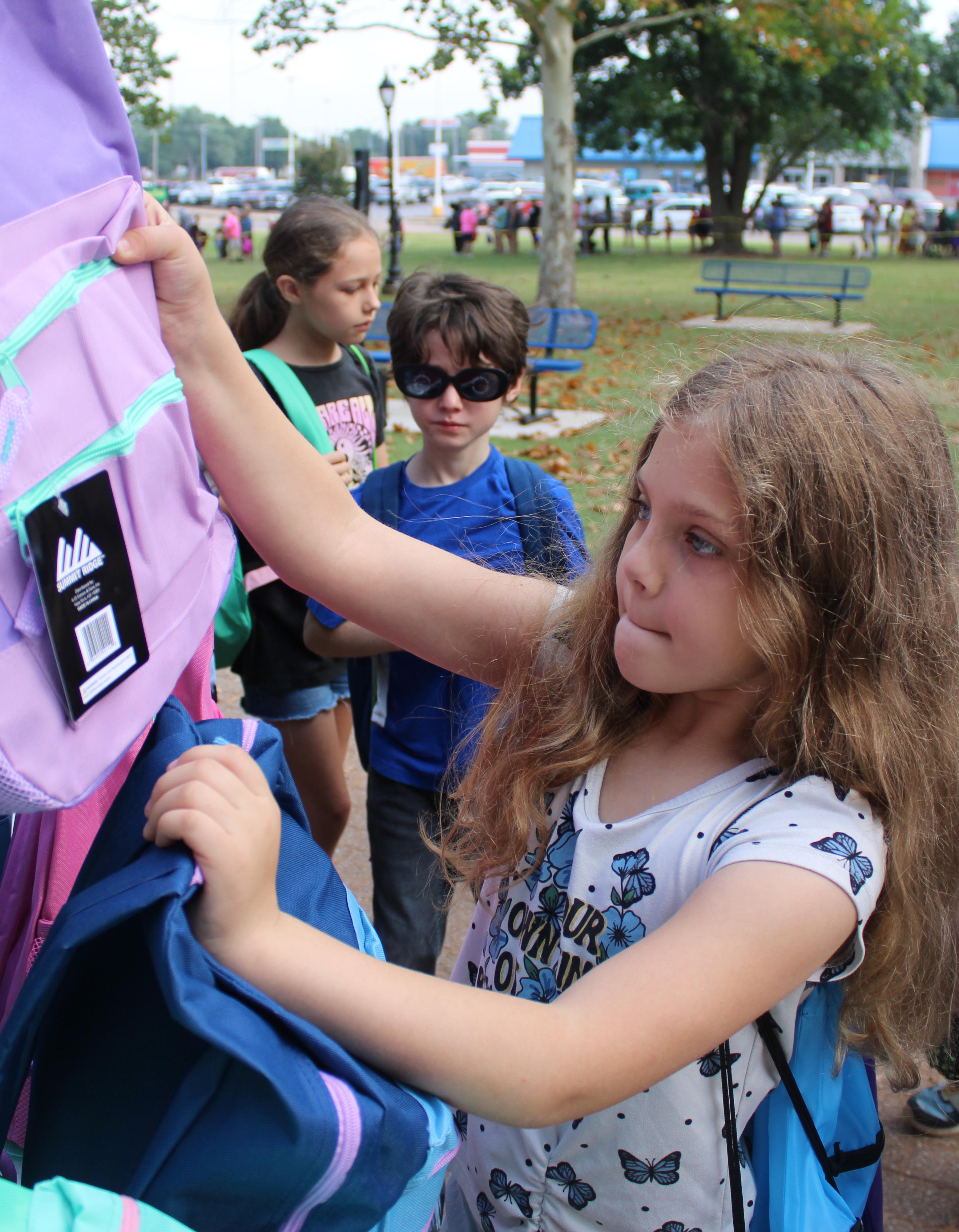


Running
Safety
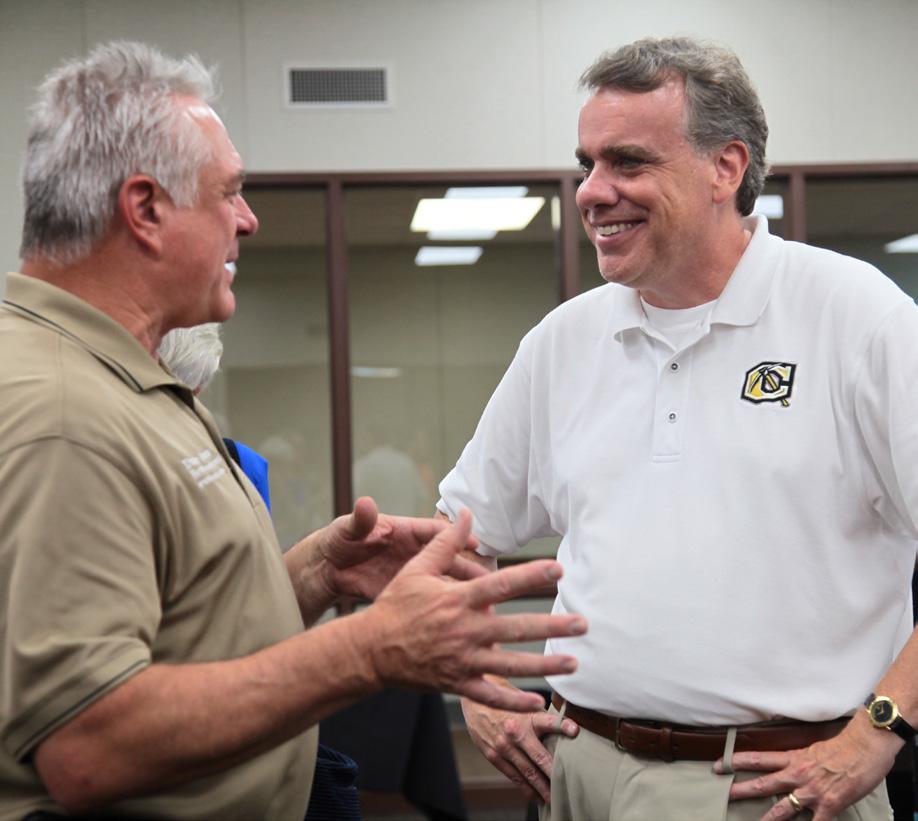







Running
Safety




Fall is here, and the season is synonymous with back to school. It’s been a while since our staff has featured our wonderful education system we have in Stephens County, so we thought it was time to turn the page back to our school districts so we could see everything new they have to offer.

We started with Cameron University, which has new leadership in President Shane Hunt along with a new Interim Director, Kyle Jarman, at the CUDuncan campus. Both have bright ideas for the future of education in Southwest Oklahoma and will look to build upon already existing partnerships while forging new ones.
We then moved on to take a look at our transportation systems
in the Stephens County area. Duncan’s district has seen some changes. While some districts have new buses, others are seeing what they can do to improve upon their systems and meet their transportation needs. I learned a lot about what it takes to keep a district running while editing this story and I hope you learn as much as I did, too.
Moving on, we took a look at campus security in Stephens County. Velma-Alma introduced a new police department and chief of police in 2024, so we took a moment to highlight the department and the man who runs it. We also took a look at how districts across the area emphasize safety.
While talking about new things, we couldn’t ignore the

changes happening in Outlaw country. The campus has pure magic happening on it thanks to bond funding that is building a foundation for a stronger future for Marlow’s students.
Lastly, we checked in on our Special Olympics and Unified Teams to see all the wonderful things they are doing.
We had more planned for this book, like always, but alas, we can only fit so much into our pages. Did you know we have an entirely new lineup of principals in Duncan’s district? We couldn’t fit them all in these pages, because each of them has accomplished so much and cares tremendously for their students, but you can find more about those principals in future editions of The Duncan Banner.
Happy reading everyone! We hope you learn as much as we did in the making of this book.


Charlene, also known in the community as Charlie, is the Managing Editor for The Duncan Banner and Duncan Magazine. She obtained her bachelor’s degree in Journalism from Cameron University, where she also held multiple positions with The Cameron Collegian, which ended with her serving as the Managing Editor in 2014-2015. Charlie has served two tenures with The Banner. Her first began in 2014 with an internship through Oklahoma Press Association and culminated in 2017 as News Editor. Her second began in 2018 when she returned as a staff writer and she resumed her editorship in 2020.
Although she has spent much of her life growing up in Lawton, Charlie has always felt a special call to the Duncan and Stephens County community. She adopted a dog from Stephens County Humane Society’s Take Out Tuesday program with The Banner in 2019 and was a member of the Duncan Rotary Club. In 2021, Charlie led The Banner to the first Sequoyah Award from the Oklahoma Press Association since its last in 2012. She has taken home multiple awards for editorial writing, news writing and design. She had her first child, Anja, in January 2024, and her second, Astraea, in September 2025.

Crystal joined The Banner staff in 2013 as an advertising executive. She was promoted to Advertising Manager in 2017 before becoming General Manager in 2020 and then Publisher in August 2023.
Crystal has won numerous awards from the Oklahoma Press Association in ad design, most recently a first and third place win for large ad space design along with second place for small ad space design.
Born and raised in Duncan, Crystal graduated from Duncan High School in 2001, joining a long line of Duncan graduates in her family. Crystal is an active member of Faith Church along with several community groups, including the Duncan Noon Lions Club.
She is a proud supporter of the Stephens County Humane Society and all Duncan Demon sports from the many years her children participated.
Crystal has three children, Alyssa, Jacob and Jordan and enjoys spending time with family and her many dogs.

Born and raised in California, Tamara joined the staff at The Duncan Banner in March 2020.
As an award winning journalist, Tamara has placed for her feature, education, business and news stories, as well as her photography and column writing over the past five years. Tamara previously gathered her experience by interning at the South Gibson Star Times in Fort Branch, Indiana, as well as working as the editor for her college newspaper, The Collegian in Oakland City, Indiana. Her experiences continued while writing and publishing a magazine, Evoke, with a group of friends in Turlock, California. With family local to Stephens County as well in the surrounding areas of Oklahoma, Tamara moved to Duncan from Stanislaus County, jumping right into community events as a reporter.
She loves to connect and engage with the community members to tell their heartfelt stories each day.
Duncan Magazine’s goal is to create a publication local to Stephens County that’s fun to read and view and created entirely by the hands of people you know. Here are the creators who use their time and talent to tell your stories.

A Comanche resident since the age of 10, Jason graduated from Comanche High School in 1991. His wife, Jennifer, followed a year behind, and the family has strong roots in the area. They have raised three daughters here, each of whom graduated from Comanche. They also have grandchildren attending school there. Jason began his career with The Banner in 2016 as a freelance photographer. Later, he accepted a full-time position in the advertising department, but he still enjoys taking photos, both for The Banner and his personal business, Hodges Photography. Jason loves his connection to the community he has now working at The Banner. He can be contacted for photography work on Facebook at Hodges Photography.

Toni has been a contract writer with The Banner since July 2024, and enjoys sharing the stories of people and history of Stephens County. Her own history with The Banner began in February 2000 as education editor. She continued in various roles, including news editor in 2013. She also was managing editor from 2003-05, at The Waurika News-Democrat. She worked at The Chisholm Trail Heritage Center in late 2013 until June 2020.
Her first newspaper job was as photo chief of The Ag Journal in La Junta, Colorado. A neighboring newspaper extended an offer as general reporter for two papers they owned.
In 1997, she moved to Marlow and worked at The Marlow Review for two years. She also was managing editor of The Review (Sept. 2022-May 2024).
Toni and her husband Rex, live in Duncan. They have two sons, several grandsons, and a granddaughter.
Her work has been published in The Dallas Morning News, The Native American Times, Cowboys & Indians, and Oklahoma Today (while working at The Heritage Center). She published a book, Riding The Chisholm Trail ‘Once in a Lifetime’ in 2009. Awards range from education to sports, photography, and tourism. She is a member of Chisholm Trail Arts Council and enjoys pursuing her landscape and fine art photography.

Cameron University aims to strengthen the relationship between CU and multiple entities throughout Southwest Oklahoma. Leading the mission is President Shane Hunt. During a recent visit to the Duncan Campus, conversations ranged from building partnerships with Duncan Regional Hospital, to the Chamber of Commerce, Goodyear and area public schools.
“The thing that has been most
wonderful and surprising is the opportunity we have right now, at Cameron, in Duncan, in Lawton, in Southwest Oklahoma, is to create jobs and an economy that all of our kids and grandkids are going to be a part of,” Hunt said.
DRH CEO Jay Johnson emphasized the importance of CU’s connection to the community.
“Cameron University has been an invaluable partner for us over the years,” Johnson said. “I’ve enjoyed
getting to know President Hunt, and I am excited about his leadership and how we can work together to strengthen and expand our workforce in the future.”
Bringing a background and passion for marketing and sales to his role as CU President, Hunt is sharing his experience and expertise with students seeking a career in this field. The U.S. Bureau of Labor Statistics projects a faster-than-average job growth in this sector. And while AI
is on the rise, Hunt knows that it still takes basic training and skills to be a successful sales person. He knows that the best way for students to learn sales is to actually get involved through first person experience.
Providing an example, Hunt mentioned a new addition to the gymnasium for fall volleyball and basketball games are two new digital video scoreboards and video score tapes.
“We received capital dollars to do that,” Hunt said. “It’s a wonderful upgrade for our student athletes and fans, but more importantly, that gives us an entire inventory of businesses and sponsorships that we can sell to, and who is going to be selling that? Our students in our sales classes.”
Hunt said the CU Center for Professional Sales will serve its students and will be the only professional sales center in the region. It ties into several things, and students in the sales and marketing classes will actively learn how to seek sponsorships that will be promoted throughout the campus, including at volleyball and basketball games.
“We want to provide more excellence, more transformational opportunities. Whether we talk about fundraising or scholarships, or concurrent enrollment and ways to expand that,” he said. “Whether we talk about our programs in Lawton and in Duncan, we want to meet more students where they are.”
Growing internship programs is key to excelling.
“The truth is we are doing a ton of internships. Our plan is to do a record number of student internships this year so they have more experiential learning,” Hunt said. “I just saw a post from our business department where two of our students are doing an internship with (a local bank). We want to provide our students with more of those experiential opportunities so they can go out. We want to expand more, for those who might be nervous and say college isn’t for me.”
Being accessible to people in Duncan, Lawton and Southwest Oklahoma is vital to the future of Cameron University.
“We will be partnering with the hospital and healthcare system here. It is our plan to have a lot more ways that
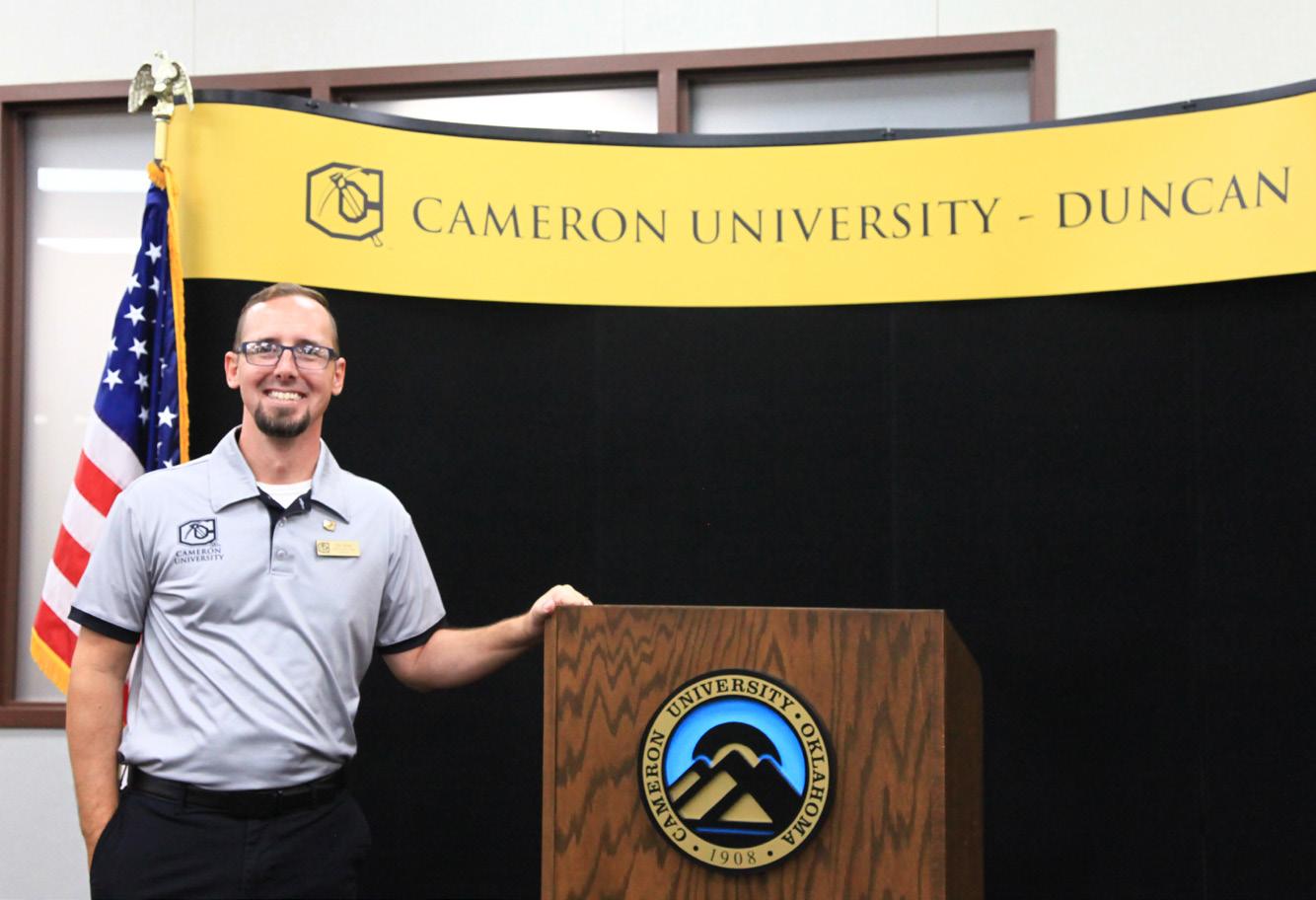
STORY BY TAMARA GREGOR, PHOTOS BY TAMARA GREGOR & TONI HOPPER
Literacy and logic, two skills utilized in everyday life, are often taken advantage of at the same time.
In the age of artificial intelligence and 30-second video snippets, Cameron University-Duncan Interim Director Kyle Jarman said it’s important to continue to hone in on reading and mathematic skills even when students don’t think they are necessary for a future career.
He said many of these skills fall into the “use it or lose it” category. He said communication skills are not going away.
Even with artificial intelligence on the rise, Jarman noted the importance of human communication.
“You can still tell when something is written by AI,” he said. “You can tell when it doesn’t have that human touch.”
Jarman noted how sometimes too much engagement with quick, digital media, such as TikTok,
could be harmful to human literacy.
“They are correlating that to the fact that we ingest quick, bitesized media all the time instead of more thoughtful print media that requires us to engage our brain, engage logic more often,” he said.
Jarman said critical thinking, math and reading will not go away.
“Those are the kinds of things that are going to keep you competitive in an AI age,” he said.
Jarman has worked at the Cameron University main campus for the past 10 years. His most recent role was Academic Services Director to oversee testing and advising.
Jarman, originally from the Tulsa area, said he was at a branch campus at Tulsa Community College. He said his wife was from Central High and they returned to the area 10 years ago.
Jarman earned his bachelor’s degree at Oklahoma State

Cameron can impact Duncan today, tomorrow, as we go forward. We are so excited,” Hunt said.
Partnering with businesses, including the Chamber of Commerce and CU’s role in this effort, Hunt said those relationships are vital in forging the future of Southwest Oklahoma.
“We have three areas we are super excited about,” he said. “Engineering, whether it’s FISTA, or Goodyear in both places (Lawton and Duncan), the demand for engineering services is high and rapidly growing, so we’re already providing more opportunities for our students. To help supply that workforce, we’re going to be opening up our brand new engineering labs. We are super excited about that and the impact that’s going to have.”
Furthering relationships with all businesses, small and large strengthens the region. Hunt hears from a variety of businesses, across all industries, about the need for more talented sales people.
“We’ve got a great product, a great idea, but we need people who are better at selling that,” he said. “A lot of older people are aging out of the
workforce. Donors are supporting these things. It directly benefits the workforce needs and educational needs of our region and that’s what we want to be committed to.”
“Sometimes in higher ed, it’s easy to teach things the same way that you’ve done that. But with the rapidness of change today, we can’t do that,” Hunt said. “We have to make sure we’re adapting that curriculum. Make sure we’re also raising money and hiring and recruiting to have the best professors in the classroom in order to give them that cutting edge knowledge.”
Hunt acknowledges the link between Lawton and Duncan as growing communities hinges heavily on Cameron providing the right education and training.
“We are linked, Lawton and Duncan cannot be the best version of themselves if we are not at Cameron the best version of ourselves and vice versa. We are committed to working with the cities, the counties
and this region to bring in jobs, to recruit companies, to help develop entrepreneurs in the next generation of people who are going to start small businesses,” he said.
It begins by making sure Cameron is plugged in and making certain that the needs of employers and the communities they serve are being met. That includes preparing students with the necessary skills.
As the new president of an esteemed educational institution, Hunt’s vision for Cameron is simple.
“Our guiding principle is to help our students. Help them to have better lives. We do a lot of amazing things, but at our core, that has always got to be our driving thing. That involves a lot of things. That involves fundraising, and making sure that we can offer more financial support to more students. So many of the students when I see them, they are like me,” he said. “They are first generation college students. So we commit to them. We are always adapting the curriculum in a way so that when they come out (graduate) in 2025, 2026, 2027, they can get a great job.”

University in 2005 and his master’s degree in 2011. He said he was motivated to pursue education because of his college experience.
“I love being in academia, a place where curiosity is encouraged,” he said. “I find education to be really transformative, hopefully socioeconomically, but just personally as well.”
He started his career as a part time advisor for Tulsa Community College in 2009.
Jarman said what keeps drawing him back into the education realm is his belief in the mission.
As an open admission institution, Jarman said CU is open to anyone.
“If you’ve got an academic goal that we can meet, come on in,” he said. “We’re going to meet you where you’re at and we’re going to support you the whole way through that.”
In filling the position as interim director, Jarman said he was excited for the opportunity to do more big picture thinking.
“Here you’ve got the opportunity to make some connections with community partners, you’ve got a chance to try some new things, there’s a little bit more autonomy involved here,” he said.
He said he looks forward to giving the Duncan campus an identity.
“I’d like the Duncan campus to be
known for excellence in this area,” he said.
Jarman said he’d like to build on student engagement and community in the area and the “quality education” CU-Duncan offers its students.
“Don’t mistake affordable for cheap,” he said. “We don’t have any teaching assistants. There’s never going be a TA teaching class or grading your papers. It’s always going to be a qualified instructor.”
Jarman said the campus also puts priority on smaller class sizes.
“Most classes are ... between 20 and 30,” he said. “Occasionally we’ll go to ... 35.”
He said the classes are small enough that instructors get a chance to know their students.
For students applying to college, Jarman said to start exploring early.
“A lot of the challenges for students in this age is they get to college, or they get part way through college, and they still don’t really know what they want to do and they still don’t really know what’s out there,” he said.
Part of their job at CU, Jarman said, is to help students with these decisions and to know what’s available.
“It’s never too early for a student to start exploring that, even if you just figure out stuff you don’t want to do,” he said.
Jarman said there’s a plethora of
different jobs which exist in a single organization, such as within a hospital, like DRH Health. He said becoming a doctor or a nurse is only one part to hospital careers.
“That’s like a miniature city,” he said. “They’ve got IT people, they’ve got cooks, they’ve got an HR department, they’ve got economic people — there’s an entire ecosystem of jobs there.”
Jarman said the earlier students explore opportunities, the better Cameron University can work to equip students for their future roles.
Jarman said he’s working with department chairs to get more traditional teachers on the Duncan campus. He said he would like to create a solid, two-year rotation where students can complete all general education requirements for a bachelor’s degree with a physical instructor on the Duncan campus.
In addition to campus work, Jarman said CU-Duncan will continue to support the concurrent enrollment growth with the rural school partnerships.
CU-Duncan enrolls around 175 students, with around 70 students at Duncan High School, and some students from Comanche, Velma, Waurika and more. Jarman said they serve roughly around 300 students from the CU-Duncan campus. DM
HOPPER
In the last year, Duncan Public Schools transportation department has been on the move and not just for driving.
The biggest change, according to Superintendent Dr. Channa Byerly, is a move to the 8th Street location and new leadership.
“The move has had its challenges, but there is more space for the drivers,” Byerly said. “The old transportation office was very tight-quartered. As far as management is concerned, I would like to believe I have helped improve the culture and morale of the department, but the drivers could tell that story better.”
Kade Golleher is the new transportation director. The district currently has one clerk, one diesel mechanic, 13 route drivers, two activity drivers, one non-CDL holding driver, a fleet serviceman and three monitors.
Discussing the details of the largest enrolled-school district in Stephens County is all about the numbers. That includes the fleet inventory.
“We have two fully decaled activity buses, three yellow buses we hold for activities, two decaled MFSABs (short buses) and one yellow MFSAB,” Byerly said. “We have 14 route buses including the one that runs to OSD in Sulphur. Of those 14, 13 of them have two routes in the morning between Duncan Middle School and Duncan High School and
elementary, and two routes in the afternoon split the same way. Sulphur just has morning and afternoon. Broken down this way, we have a total of 54 routes.”
There are 19 total drivers in the DPS transportation department, and 15 of them are on six hour contracts. The other four are 8 hour contracts. Not all coaches are certified. Byerly is certified and can drive a bus if needed.
“The biggest challenge is making sure we cover routes and activities adequately,” Byerly said. “We have managed it, but it definitely takes a collaborative effort between Transportation and the coaching staff. Also, about half of our DMS/DHS routes are at capacity. Our oldest bus is 101, and I believe it was purchased around 2010, give or take a year or two. Our most recent purchase is 102, a special education bus we got in spring of 2025. We are looking at the possibility of another full-sized bus or a couple short buses. We are trying to ascertain which need is greater, and therefore which purchase is more beneficial.”
Byerly said they are always looking for route drivers, noting the requirements which are a Class B CDL with P and S endorsements.
“A positive

disposition and desire to work with kids is a must. This would bring us back to being fully-staffed,” she said.
Marlow Public School District has had its challenges in the last couple of years when it comes to the transportation department. A bond issue in the summer of 2024 failed, just shy of the five extra votes needed. Superintendent Corey Holland said there are no current plans to seek another ballot. Instead, he will explore all options to see how the district can get the buses they need.
“It was disappointing. I take the blame on that. I guess I didn’t communicate the need well enough,” Holland said. “We still have a need, still have a shortage (of buses). We had to borrow buses from Duncan Public Schools when ours were down. To me, that’s embarrassing, but we are grateful that Dr. Byerly would do that. You do what you can do to help kids.”
Holland said there are no plans to call for another transportation bond issue.
“We will be trying to exhaust all other options first,” he said.
Options include lease purchase possibilities, and buying used,

which he’d like to avoid.
Marlow has 16 buses in its fleet and runs nine routes, said Athletic/ Transportation Director Daryn Brantley. Holland said while it is enough for routes, sometimes they are down four or five buses. At the time of the interview, the district only had two buses out of service. When activities are up, for example in the spring season, it can be a strain and Brantley stays busy making sure everything is covered.
“We have kids going 100 different directions. Say the golf team, both boys and girls are gone, then you let the baseball team go, track teams both high school and junior high, and very quickly we don’t have enough buses to do routes,” Holland said. “Sometimes we have to double up on routes. It’s a juggling match. In August, we had a softball game that rained out, then we had to make up on another day. It’s a good problem to have because it means our kids are active and getting to do things. It’s a need, not a want.
“Invariably in the last couple of years, the buses are breaking down because they are older. We’ve already had four or five in the shop this year. There’s lots of wear and tear on them.”
Marlow recently joined a program thanks to a grant in which all buses were outfitted to include both regular fuel and CNG fuel. Because of the grant, it has not cost the district anything and there will also be a CNG fuel station installed at the bus barn.
“What it does, it ups our miles per gallon. It burns cleaner. It extends the life expectancy of what
we have,” Holland said.
Marlow has a dedicated bus shed for its fleet inventory. All coaches are also required to be certified drivers.
“If you are a coach, you are going to get one. I’m not paying someone to drive them (coaches),” he said.
After the vote, Holland obtained voter rolls to do some independent research. While the rolls do not tell how an individual voted, and he didn’t ask people that question, he wanted to know opinions and what he could have done differently to get those necessary votes. One misconception was that some people thought the district just wanted new buses for air conditioning.
“That’s the standard, they come with it. Just like vehicles have electric windows,” he said.
Buses average about $150,000 and if the district has to figure that into the budget, it will be a give/take issue in which that money won’t be available for something else. And while some schools, like Geronimo in the next county (Comanche) and less than 45 minutes away, have started moving into the electric vehicle (EV) mode, that isn’t in the budget for any school district within Stephens County, especially Marlow.
“They are $400,000,” Holland said. Additionally, other costs also figure into keeping those operational.
Rural routes are hard on buses. BrayDoyle Public School has five routes and nine buses, which includes one activity bus. They also have vehicles for the FFA-agriculture
department. In January 2024, a band trailer was donated by Nextera. The district is unique when it comes to voting for any school issue. BDPS covers three counties – Stephens, Garvin and Grady , which are extremely supportive of the needs. Prior to Superintendent Dr. Smith Steigleder’s arrival at the school, the district purchased a couple of buses in 2021-2022.
“Our bus routes are a little longer than what you see in town,” Steigleder said. “All are gone for over an hour.” The afternoon route is from 3:20 to after 5 p.m.
Certification/accreditation of drivers is not a problem, Steigleder said.
“We haven’t had an issue. Right now, everyone who is certified to drive a bus works at the school,” he said. “We have 14 certified and on top of that a couple people that can come in and substitute. We haven’t had a situation that we couldn’t get covered.”
Steigleder knows exactly what it takes to become certified.
“It is hard to find people that are certified. They make it hard to take that test. I have a doctorate degree and I don’t know of any test harder than that test,” he said and laughed. “There are three tests, many districts have a fourth one for air brakes.”
Several of the district’s employees have attended training at Fort Cobb VoTech Career Center.
“Everybody that drives a bus is already employed here,” he said. “We have Matt Tillson, Matt Lucas, Glenda Morgan and Mr. Arlyn Cox, Eric Mayes, Justin Price and Jake Kilborn.” Robert Alvarez is the transportation director and maintenance supervisor.
None of the route buses are old, on average about five years, but none over seven, he said.
“We put
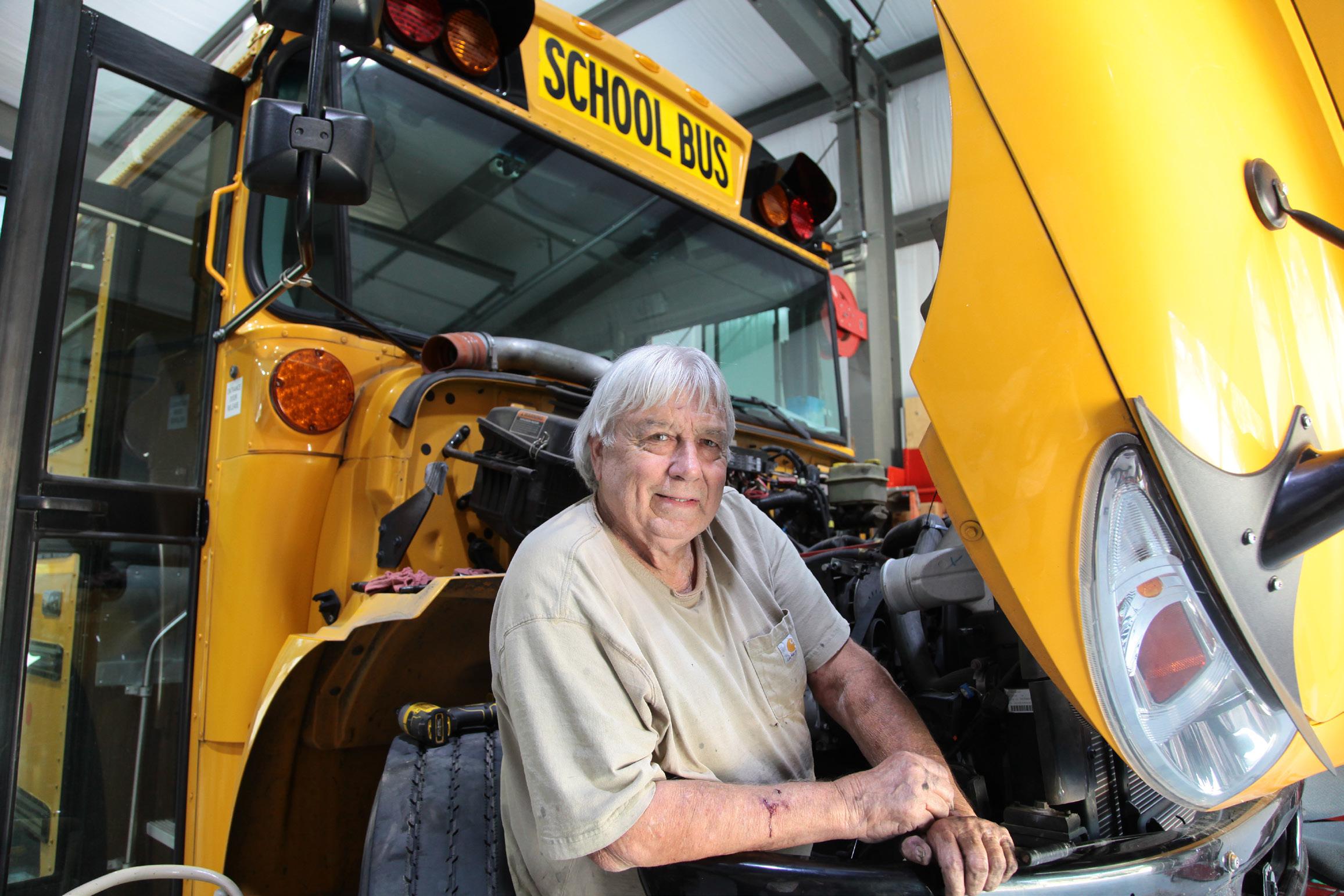
so many miles on them and the wear and tear is a bit more because of the rural routes,” he said. “Our plan right now is when the two on a bus lease fall off in two years, we will buy a couple new buses. It keeps our fleet moving along.”
There are also plans to build a bus barn once the main campus construction is completed.
Comanche Transportation Director Sean Hushbeck said they have 22 district employees with bus driving licenses.
“We have one new route driver we hired this year and we hired one coach who was already certified.,” Hushbeck said. “We reimburse employees who get their licenses.”
Fleet inventory includes nine route buses and two big activity buses. Phone charging ports and racks are available on the activity buses. Most of these were purchased about seven years ago, he said.
“Our buses are still in pretty good shape,” Hushbeck said.
Raymond Rice, Velma-Alma superintendent, said they have about 10-12 route buses for four routes, and an
activity bus.
“We do not have a bus barn but we do have a place, a shed to keep them out of the weather,” Rice said.
Like most districts, they have a couple spare buses for parts.
According to Rice, “finding certified bus drivers is a real challenge.” He factors in the issues in having retirees as they have to be available every morning and evening. He said many staff members are working to obtain their certification.
“It is a real challenge to get these people certified, a multi-process challenge,” Rice said. “We keep adding to our fleet every other year to keep the fleet modern.”
It boils down to making sure students are on safe buses, he said.
“We buy them out of our hip pocket,” Rice said. “Buying an activity bus is expensive. Those are about $250,000.”
Empire High School Principal Tim Whaley, who is also the transportation director, said the fleet has 11 buses, including two mini-buses and an activity bus. A plus is that 12 district employees are certified to drive a bus.
“We run six routes both in the morning and afternoon. Three have air conditioning, which is necessary, especially in August, September and

May. It’s also a safety issue,” Whaley said. “When you have a bus idling 1012 minutes in line, it can get up to 120 degrees. Most people wouldn’t drive their own vehicles in that hot weather.”
Empire’s last new bus purchase was four years ago, he said.
Bluebird was trying out propane buses. The propane bus models burn cleaner and are more efficient. Whaley said that prices for all school buses have dramatically increased just in the last few years.
“Rural routes tend to beat up buses a little more. When you have mechanical issues, for example, a warning light or stop arm, you have to deal with those right away,” he said. “When we get into seasons with multiple sports, we run into issues with scheduling.”
Central High Superintendent Kevin Dyes said the district has four route buses and two activity buses (two diesel and four gasoline). They also have three route drivers, 11 certified staff, eight of whom are coaches. Like Marlow, all coaches are certified to drive buses, and they do have a bus barn. Challenges, like all the districts, include the paperwork and route driver schedules.
































STORY BY TONI HOPPER, PHOTOS SUBMITTED
School security is a priority and most districts have a School Resource Officer on the payroll. Velma-Alma has taken additional steps by having its own police force – of one CLEET certified officer. CLEET is the Council on Law Enforcement Education & Training.
Raymond Rice, who has been in education for 36 years, and now in his 13th year as superintendent at V-A, enjoys talking about the school’s police department. Rice started as an FFA-agriculture teacher, so he has seen plenty of changes and knows the importance of evolving with the times.

MATT PURNELL, CHIEF OF POLICE FOR VELMA ISD CAMPUS POLICE DEPARTMENT, STANDS WITH HIS UNIT OUTSIDE OF THE VELMA-ALMA SCHOOL BUILDING. PURNELL SWORE INTO THE POSITION IN 2024 AND ENTERED HIS SECOND YEAR WITH THE DISTRICT THIS YEAR.
“Several years ago, we thought it would be nice to have a resource officer on campus,” he said. “Matt Purnell is Chief of Police for our school. This is his second year. What we realize is he’s one of us and has a great deal of value.”
It was made official by the district’s Board of Education at a meeting in July 2024. Purnell’s background includes serving as a deputy with the Stephens County Sheriff’s Office, with the Fort Sill police and 20 years in the United States Army.
“I’ve held many positions of public trust over the years. This position being the most rewarding, and the most
important,” Purnell said. “Because I protect what matters most.”
With an enrollment of 430 students this school year, that keeps him busy as he makes the rounds. Even though the district has its own Police Department, they do rely on both the SCSO and Oklahoma Highway Patrol if needed.
Rice said Purnell is constantly building a rapport with the students.
“He interacts with them and greets the elementary students daily,” Rice said. “I don’t know that we can fully realize the impact he has made on the
students. Who can measure the positive impact the role he has on these students?
“He is security and there are times he has to jump into that law enforcement role. Not a lot of school districts have a live police department. We’re proud of that.”
Rice said one of the reasons for having an actual officer on campus is because they are about 20 minutes away from Duncan and that response time can be critical. An example would be if the sheriff’s office and OHP are at the opposite end of the county, it
could take even longer if they are tied up with another response. Usually, the departments are quick to respond, but considering variables, having an officer on campus provides more security.
State allocated funds of $92,000 for the last three years have helped offset the officer’s salary. That funding also helped the district install cameras with audio, electric locks, among other items. All districts in the state received the funding, said each of the area superintendents interviewed.
“You aren’t going to get in unless we let you in,” Rice said.
Like Velma-Alma, all the campuses throughout the county have electronic doors in place and additional measures that visitors must go through to get into the buildings. At Empire, High School
Principal Tim Whaley said the district also has one person dedicated to daily maintenance that is security related, for example, doors that aren’t properly latching. That becomes a priority.
“We address that immediately,” Whaley said. “When we start paying attention, then we start seeing all the little issues.”
Whaley said because a school like Empire, and many in not only Stephens County but throughout Oklahoma, are rural, additional factors are considered.
“We are spread out and adjacent to fields and pastures. Fencing is a challenge,” Whaley said. “We want it to look aesthetically pleasing but not confining, just secure.”
Empire Superintendent Justin Smith said the camera security has doubled in the last two years, and confirmed they have the buzz in door systems for all entryway doors.
“We have gates set up on phone apps to reduce driving completely around our campus. We have an armed licensed security guard during school hours and most extracurricular events. We have replaced several classroom doors that provide more security as well,” Smith said. “We do feel good about our security but are always trying to improve in that area.”
Whaley said multiple drills are conducted throughout the school year.
“Intruder drills, lockdown drills, tornado, fire, gas leaks, flooding drills. It’s very real for us,” he said. They also make sure lighting around the perimeter is working.
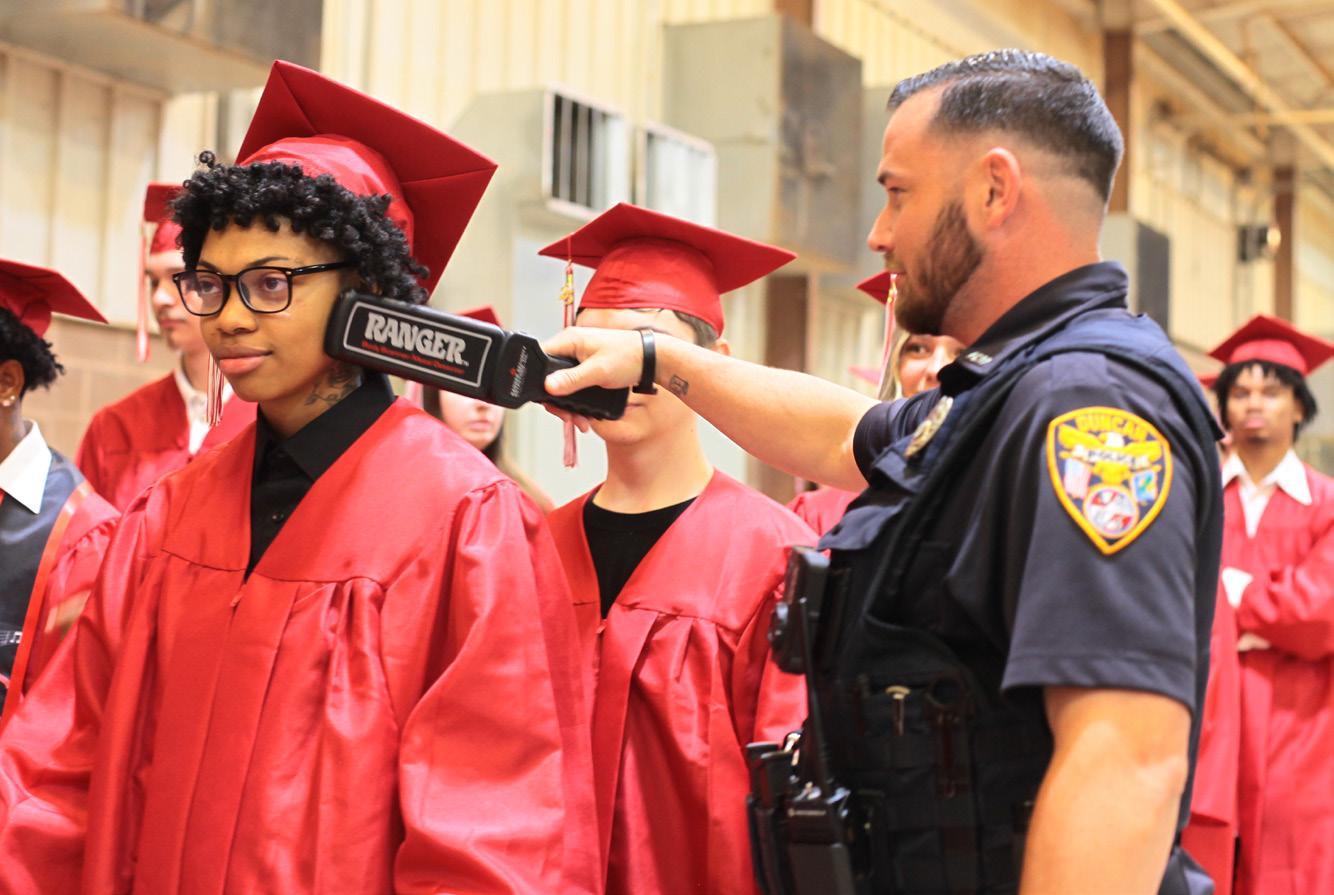
SCHOOL RESOURCE OFFICER CODY EARLS USES A SCAN WAND DURING A GRADUATION CEREMONY LAST YEAR.
STORY BY TONI HOPPER
The bell rings and the teacher immediately instructs everyone to leave their books and belongings behind and exit out the nearest door. It could be a fire, a tornado warning in which case everyone would head to the designated safety room, or some other incident, such as a hazmat spill. As students and staff gather, the noise level increases. It’s a safety drill.
And it is mandatory.
Dustin Smith, security director for Duncan Public School District said: “We are required to perform a number of drills every year, and many of those drills have a mandated window of time within which they must be conducted. For example, we are required to perform one bus evacuation drill,
one security drill and one fire drill in the first 15 school days of each semester.”
Tornado drills are required every September and March, he added.
“Throughout the school year, additional drills are performed, such as additional security drills, evacuation drills and medical drills,” Smith said.
Safety goes far beyond just conducting drills and for DPS, a team of resource officers handle a variety of issues daily. This includes making sure all campuses are safe. Smith said the district utilizes a hybrid approach to school security personnel, with both the high school and middle school having assigned resource officers on campus.
“These officers are employed
by the Duncan Police Department, and assigned to our campuses on a contract basis,” he said. “The district employs a School Safety Officer to provide on-site physical security for the elementary campuses, and to act as a liaison between those sites and the School Resource Officers.”
At the high school is SRO Cody Earls, the middle school has Allion Bray and the school safety officer at DMS is Cayd Hall.
“All three are absolutely invaluable to the safety of our students, staff and guests,” Smith said.
All officers at any time can be called to any school within the Duncan district. Visitors to any events, graduations or athletic games, will also see the officers on duty. Attend a Friday night football game and your bag does get a quick inspection at the gate.
An annual allocation of about $92,000 has been funnelled to all school districts within the state of Oklahoma for three years.
It is strictly used for upgrading security and to help cover the salaries of the SROs. It can also be used for fencing, audio and video surveillance, school check-in software, among other items.
“We will not know if that funding stream will be renewed until the next legislative session,” Smith said. “That funding has been used by Duncan schools in a number of ways. It has allowed us to upgrade our alarm systems at a number of our sites, to provide relevant and appropriate training to our security staff and to equip that staff with a number of life saving items.”
Smith also said the district is currently in the process of an upgrade to its entire radio system, thanks to the funding.
“This upgrade will allow our security staff and our sites to communicate with our transportation assets, as well as give those assets the ability to communicate with law enforcement in case of an emergency,” he said. “This radio upgrade will also allow us to increase communication effectiveness at athletic and other large scale events.”
Video and audio surveillance has long been a priority for schools. Having the state funding is a bonus.
“All vehicles that are used to transport students have video and audio surveillance. In addition, all vehicles owned by the district are able to be tracked at all times. This allows
transportation and security staff to respond to any emergency in as timely a manner as possible,” Smith said.
“We are in the planning and bidding process for additional fencing projects at two of our sites using these funds. These fencing projects will complement the comprehensive fencing component of the bond passed in 2020,” he said. “Alongside these large projects, the district continues to expand and upgrade the camera and visitor access components of the overall safety framework.”
Most parents who visit a Duncan school are aware of the entry process. Long gone are the days of just walking in a school building to pick up your child or see a teacher. Duncan High School has a layered security measure in which a visitor must be buzzed into the front office, before having to present identification and follow a few more steps using the SchoolSafeID system. The kiosk system handles “visitor management.”
“Every visitor must check in with that system using their government issued ID. That system then takes a photo of the visitor, and automatically checks them against vetted databases,” Smith said. “The system is looking for various things such as sex offender or violent offender registrations. Once the visitor has been cleared, a sticker is printed that the visitor must wear for their entire visit. When the visitor leaves, the system is again utilized, checking them out of the site. In addition to checking them for safety, this system also allows us to know who is in our buildings in case of an emergency.”
Smith’s team of officers also deals with visitors who might think they have automatic access just stepping onto the property as was the case recently with a particularly loud protester at the high school campus. Conducting free speech doesn’t necessarily give an individual a carte blanche pass. He was asked to move off campus where he continued his diatribe. Even then, the SROs made sure they were visible. Though the man was physically off school property, the officers maintained watch. The incident lasted several days after students were released at the end of a school day.
“Duncan Schools has made strides in making our schools safer, while maintaining a welcoming environment focused on education, student growth and community engagement,” Smith said.

MATT
Bray-Doyle Superintendent Dr. Smith Steigleder said the state funding allows smaller schools to address more projects. Smaller campuses means less buildings to install cameras, and similar functions.
“We have a full-time resource officer who is a sheriff’s deputy, Officer Medina,” he said.
The funding allowed BDPS to install fencing and controlled access to all three campus buildings, plus the gymnasium. A program, Safe ID, requires visitors to scan their driver’s licenses or state-issued identification cards. With the driver’s license, the scan alerts the district employee if there is anything that could be of concern, from custody issues and more.
“That system is beneficial for things like that. We have all new security cameras district-wide that are hard-wired in for surveillance. It was the biggest expenditure at $80,000,” Steigleder said. “We’ve done quite a bit with safety over the last couple of years and all buildings are on lockdown. Uvalde was a reminder about how dangerous an unlocked door can be.”

Marlow Superintendent Corey Holland echoed what many of the other district leaders said they had in place, also using that state funding. Yet, Holland shared a closer look at what campus security means.
“I’ve really tried to be more intentional about our campus and make it be more accessible,” Holland said. “People may not even notice, but we installed more wheelchair ramps, and access points at the football field where we built two new areas of seating for people in wheelchairs or for those who struggle to get in the stands. I’m proud of that. We also have more handicap parking.”
At the end of the 2024-2025 school year, Holland said he was standing outside the north entrance of the elementary building when a parent drove up with her child.
“She helped her child into a wheelchair and then started pushing the chair away from the entrance to the ramp on the corner.”
Holland said when he
looked down and saw the curb, he apologized to the mother when she returned.
“I said I am so sorry and I told her there will be wheelchair access here. Now there is one. I’m just trying to think about students and our people and how they are impacted.”
He is looking at improving wheelchair access at the Outlaw Gymnasium.
“It isn’t necessarily education, but it’s the experience people have. It’s the little things,” Holland said. “We want people to feel appreciated and I’m thankful the board is allowing me to do these things.”
Central High also has a fulltime school resource officer on site, said Superintedent Kevin Dyes. And they have a camera system.
“We upgraded our phone system recently,” Dyes said. “Each class has a phone and call-in and announcement capabilities.
CHPS also added a full-time nurse, which Dyes said is “a luxury for a small district.”





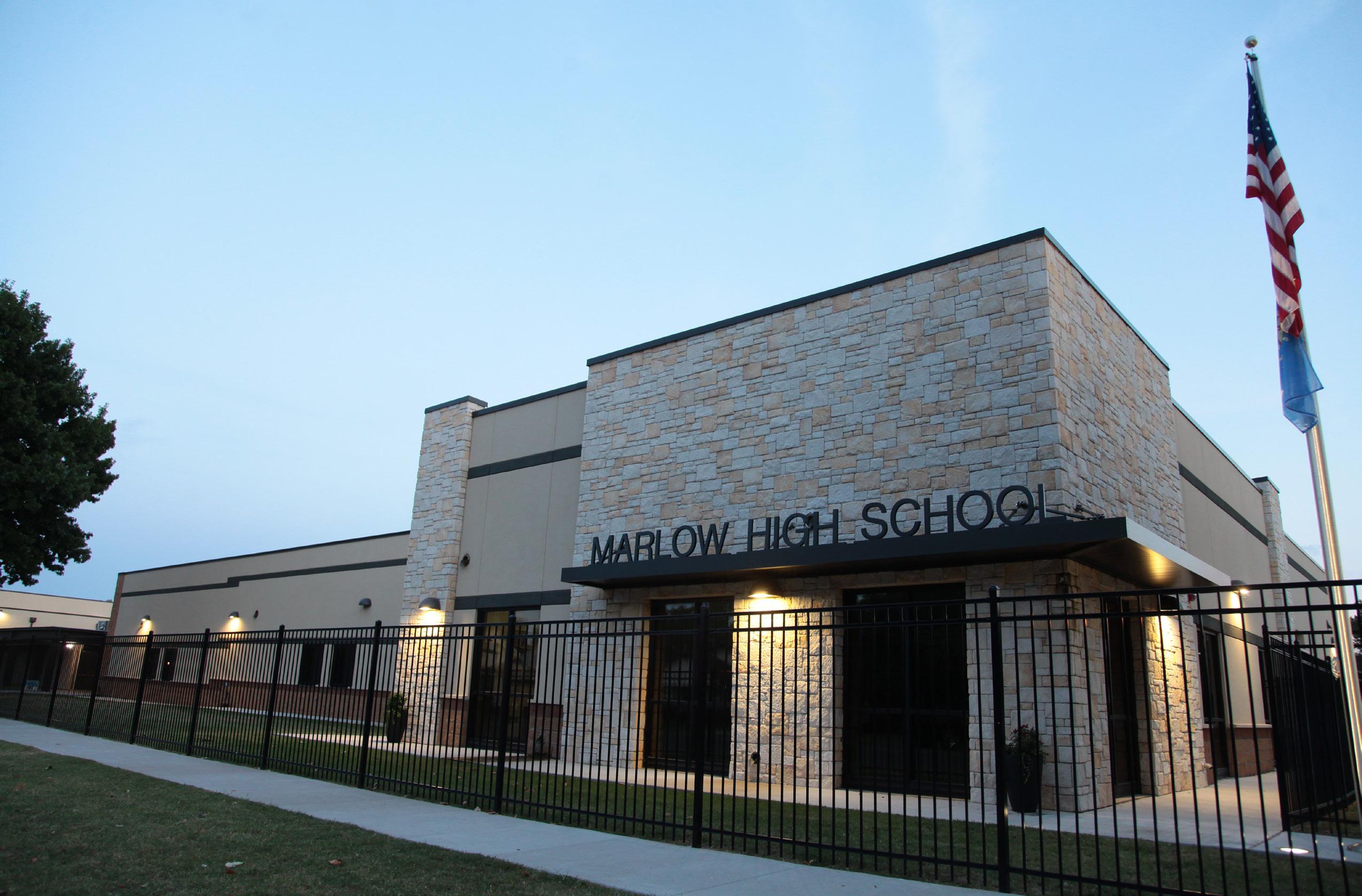
STORY AND PHOTOS BY TONI HOPPER
Marlow Public School District is the foundation of its community. If there is a school event or game happening, it’s a pretty good bet that if you are looking for someone, they will be there –wherever there is at the time.
It’s Outlaw Spirit. Outlaw Strong. It’s a culture. It’s Marlow. Drive down Main Street and you will see that this community’s investment is strong. A foundation has been built and it is more than just cornerstones on new buildings.
It is a $34 million investment to build a stronger community for future generations. Enrollment is 1,375, of
which 365 are high school students. This year, several graduates returned home and are now members of the faculty.
“Our theme this year is Outlaw Strong,” said Superintendent Corey Holland, also a product of Marlow Public Schools and community. Holland graduated in 1988. He was hired in Marlow as a teacher and coach in 1994. In 2008, he was elected to the Oklahoma House of Representatives and served two terms. During that time, he earned his master’s degree in educational leadership from Cameron University. He was hired in 2012 as the Cache
High School principal, and in 2016, was promoted to assistant superintendent. In July 2022, he was hired as Marlow’s superintendent, just as it was time for the bond project to break ground.
Attracting new teachers to a small community isn’t always easy. In fact, it can be more challenging to get graduates back home after they have left and earned their degrees. Five not so new faces have joined the faculty ranks, and not all of them are from Marlow, although Holland said most of the faculty are from Marlow.
“The vast majority are graduates of Marlow. They know the culture, the
expectations and have a relationship with families,” Holland said. “I like bringing back former students. They had a positive experience here and they want to be a part of it and help grow it.”
Returning this year, Rylee Blythe (2016) stepped into a position held for 43 years by Paula McConnell, who retired at the end of last school year. Blythe was a student in her speech and drama program and is excited about the chance to build the program in a new space; Hunter Hicks (2014), teaching sixth-grade language; Drew Wortham (2009), high school freshman history and coaching assignments for football, basketball and baseball; and Nolan Herchock (2019) elementary school adapted physical education and coaching assignments for softball and baseball.
Joining the district roster also is Erin (Herchock) Bergner who married Wyatt Bergner (2018); and Cameron Harris. Bergner is teaching sixth grade social studies, is the middle school girls’ basketball coach and assistant track coach for both middle and high school girls. Bergner previously taught at Marlow in 2020-21, and 2021-22.
Harris is the district’s new Media Communications Director. Though she isn’t originally from Marlow, she married Brock Harris, the grandson of the late Coach Ron Newby, and son of Kirk and Julie Harris. Kirk is the MHS basketball coach and Julie is a counselor at Marlow Elementary School. Brock also coaches football, basketball and golf. It’s those layers that build the strength of Marlow.
Dating back to the late 1898, this
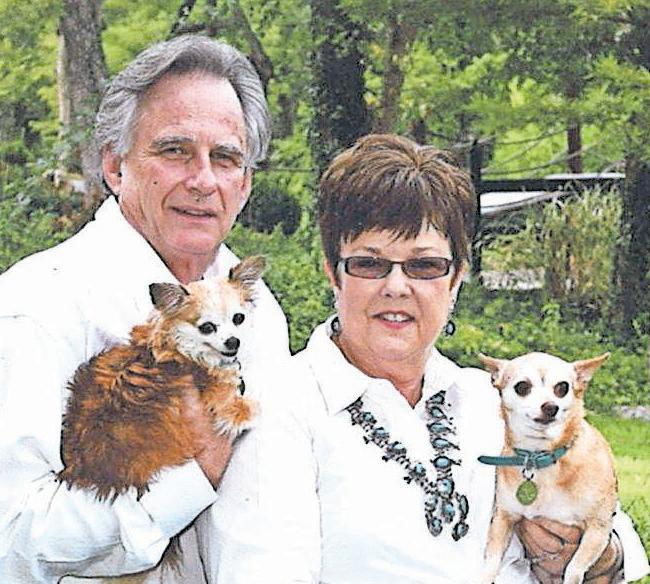
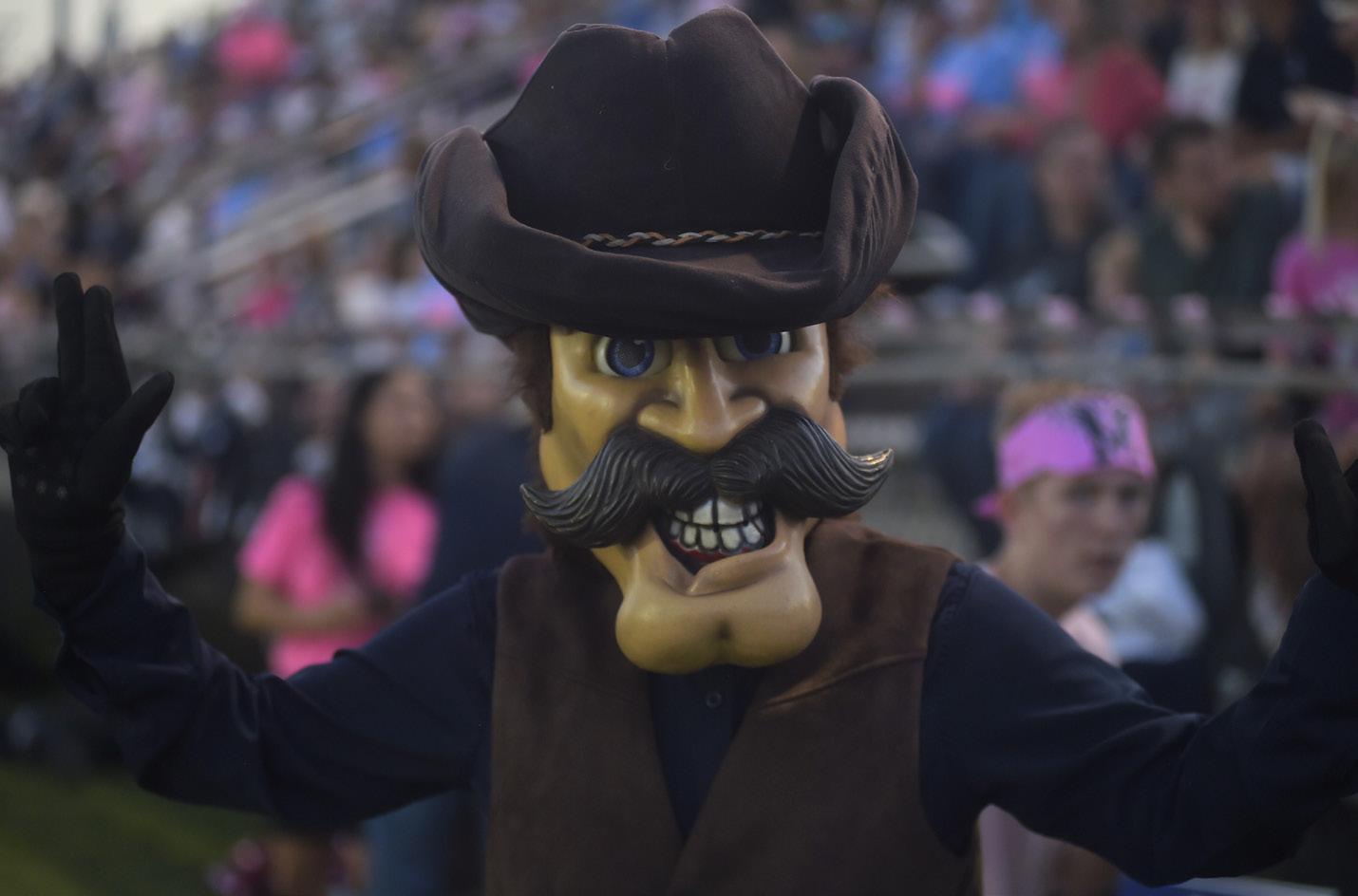
community proudly carries its history and traditions forward.
Landmarks like the First Methodist Church and the dome gym on the high school campus are familiar signs to former residents when they visit. One such landmark no longer exists. The old brown auditorium served as a community attraction, for school plays, performances and many other events. Just before the start of the 2022-23 school year, a wrecking ball demolished the historical auditorium that was completed in 1938 as a WPA project. A near-century old building can put a strain on the annual budget. And there were other factors to consider.
Holland said the old building was great, but had issues because of its age.
“That change is massive. The experience they can have, the classrooms they have. The learning
spaces are vastly improved,” he said.
What was once eight cramped classrooms and a band room is now three spacious classrooms for speech, choir and band on the west side of the new Performing Arts Center.
During construction of the PAC, no major cuts to the project happened. Holland said it could have been a temptation to cut that big project down.
“We did make small cuts, but that’s the anchor to the whole thing. We tore down a building that people were in love with. People were climbing the fence and grabbing bricks off that old building,” he said. “That is a school thing, but it is also a community thing. We’ve got to get that one right and it’s got to deliver as much as it can.”
The stage at the back of the building came down in height.
“It didn’t affect anything. It was more aesthetic and I did that with the

Safe Rooms too. They were originally taller,” he said. “The PAC, out of all the projects, is the one I’m most proud of and I think the community will get use out of it.”
Holland said it is the cornerstone for the school and community. Recently, two events have already taken place at the PAC that connect school to community. One was a safety seminar “Outlaw Strong, Online Smart” open to anyone throughout Stephens County. Another was Constitution Day during which 46 high school students were able to register to vote, thanks to the Stephens County Election Board Office.
With the start of the 2025-26 academic year, all slated projects were completed in the three-year time frame. Construction of a new high school building and additional science classroom building, an athletic field house, two tornado safe rooms at both the high school and middle school campuses, and a wrestling facility have all been signed off as finished.
“Out of our original bond proposal, the concession stand was the only one that wasn’t built as brand new. A lot of factors ended up impacting
the availability of the cost. All the other things in that proposal were completed,” Holland said. “From shortages that drove the cost of construction up, the reason being, it became very clear. We got to see those costs work their way down over the three years of building. Because the fieldhouse was being built last, the district was able to get more footage than originally anticipated. Compared to what we started at, it was still expensive.”
Adding in the two tornado safe room buildings included deadlines for completion, making those a top priority. Former Superintendent George Coffman, Assistant Superintendent Brenda Parker and the Board of Education applied for a FEMA grant prior to Holland’s arrival (after Coffman’s retirement).
“Dealing with the federal government during COVID was not ideal,” Holland said. “When I got here in July 2022, I started looking at what was passed. Of course I was aware of it because I live here and voted for it. Now (as administrator) I really got to understand the depth of it and it became clear it was going to be a huge challenge. The funds and the massive commitment by the
community.
“Just because of the cost, it was going to be really hard to deliver on these things we said we were going to do,” Holland said. “I didn’t want to come in as the new person and under deliver. Right off the bat, working with the board, we prioritized what touches the kids. What are things kids use? Adult use takes a back seat. Over the course of the project, it became clear I would have to take reductions on a few things. We changed original plans, reworked and scaled back.”
New concession stands at Outlaw Stadium were eliminated.
“We added on to our existing bathrooms and we have plans to redo the visitor side as well,” he said. “Our original motivation was that anything that touches a kid would be finished.”
Initially, the district expected a reimbursement of 75% of cost for the safe rooms, and once the grant was submitted, nothing could be changed in the original request. By the time it was approved, it was two years after the pandemic and post COVID-19 material costs were higher. Holland said he was confident the district recouped about a 60% reimbursement.
“Safe rooms not only touch the
students, they also touch the community,” Holland said.
“Right after the bat on the first two builds, we were way over budget. We haven’t gotten a dime or penny over what FEMA tells you, in the pre-COVID budget. A second application has not resulted in more funding.” Holland cited natural disasters, hurricanes, floods and wildfires, which probably moved to the top of the list for FEMA.
In the process of tearing down the old auditorium, asbestos was discovered. That added additional costs and a six month delay during the abatement process. It raised the question of what they might discover in the old high school building if they followed the plan of having an enclosed walkway to connect the old and new classroom buildings. Everything would have to be brought up to code, so the gap between the buildings remains for now.
As for the old wrestling room on the east side of the football field, it was slated for improvement. But when bids began rolling in, Holland said they realized for the field house that a brand new large rectangular building could be built without affecting the budget.
Repurposing the old wrestling gym allowed the district to gain a place for special education physical education, with mats. MPS now has three gymnasiums – the original dome gym, the elementary gym and the Outlaw Gymnasium on 9th Street. Behind that gym is the new wrestling facility with three full mats.
“Not many high schools have that,” he said.
Educational instruction is easier.
“We moved the lower grade levels, ninth and 10th grades, into the new high school building which allows the transition from middle school
to the high school easier. Visibility is much better,” he said. Students only have to walk down the one long hall to switch educational and art classes. “We’re not all on top of each other.”
Holland said the support of the community doesn’t go unnoticed by students at every grade level.
“The bigger thing is the culture we’ve got going on. We have great people, great parents and that’s what makes it work,” Holland said.
“We don’t give them (students) enough credit. We communicate it to them to take care of this, take pride in it. The community stepped up and the students are so grateful. You think kids aren’t tuned in, but they are. Just because they don’t verbalize it, even little kids,” Holland said, providing an example. “We put shade over the playground and they said thank you. They are dialed in and it’s evident in how they take care of it.
“Say you go to a restaurant, and pull into the parking lot. There’s trash and weeds. It doesn’t mean if you go in there they won’t have good food or it won’t be clean, but it does tell you something. You give students, the staff, functionable nice stuff, they take pride in it. It lets them feel appreciated. We are fortunate to offer that. Not every school can, not every community supports that.”
It’s the Outlaw Strong attitude. “Our people love the kids, the school. We’re not perfect. Not everybody here is 100% on board, that’s normal for any organization,” he said.
A building may just be brick and mortar, but these buildings represent strength and safety. And hope for the future generations.
“Marlow students now have opportunities like never before to learn, grow and succeed,” Holland said. DM



STORY BY TAMARA GREGOR, PHOTOS BY JASON HODGES AND SUBMITTED
Through inclusion comes friendship and through friendship comes the strength and unity to form special Olympic teams within Stephens County school districts.
Duncan Public Schools and Comanche Public Schools each have developed unified teams within their retrospective districts over the past few years to bring teamwork, hard work and determination together for some Stephens County athletes.
In 2022, Duncan High School received recognition as a State Champion Banner School and has continued to represent the title in 2023, 2024 and 2025. Additionally, Comanche High School received its recognition as a National Unified Champion School in September 2025.
Duncan Special Education Department Head and Special Olympics Head Coach Toni Howard said one their groups will participate in the Unified Volleyball program and another group will participate in Unified Softball in the spring.
Howard said the Unified Volleyball team placed third in the state three years ago in 2022.
“They are on a mission to make it back to State this year,” Howard said. Howard said the team competes at various schools across Oklahoma.
“We have traveled to Edmond, Santa Fe and Yukon so far,” she said.
In September, Santa Fe South traveled to Duncan. She said Duncan will also host Piedmont and Edmond Santa Fe over the next few weeks.
Duncan’s Unified Team practices during the afternoon physical

IN MAY 2025, COMANCHE SENT FOUR PAIRS OF ATHLETES TO COMPETE IN THE SUMMER STATE GAMES AT STILLWATER WHERE THE TEAM COMPETED IN UNIFIED CORN HOLE AND TOOK HOME GOLD AND SILVER MEDALS.
education time during the week.
Howard said the Duncan High School Unified Volleyball team would love to see their community in the stands this season.
“These incredible athletes work tirelessly every day, pushing through obstacles and celebrating victories big and small,” Howard said. “They are achieving goals left and right,
showing us what true teamwork, determination and heart look like.”
Howard said the team appreciates any support from the community.
“Whether it’s cheering from the bleachers at a home game, spreading the word or simply encouraging these athletes as they represent DHS with pride,” Howard said. “Your presence makes a difference, and every clap, cheer and smile fuels their spirit to keep going.”
Howard urged the community to come to the games, join in on the fun with the team and be part of the journey.
“Together we can show our athletes just how much their hard work and dedication mean to all of us,” Howard said.
Howard said Unified Special Olympics is more than just a sports program, it’s a movement.
“It’s a movement that continues to grow here in Duncan and across the state,” Howard said. “Our athletes and their partners not only compete, but also create lasting friendships, build confidence and develop skills that will serve them for a lifetime.”
Howard said players look forward to making memories.
“Each practice and competition is filled with memories in the making, and every event gives our students a chance to set new goals and push themselves to achieve more,”
Howard said. “The community’s encouragement means everything to our athletes.”
With eagerness to represent Duncan and make the community proud, Howard said the players are excited every time they step onto the court, field or track.
Howard said funding is also limited for the Unified Team and any donation or community support is always appreciated. She said this helps the coaches to continue to provide opportunities for the athletes.
“Together, we can keep Unified Special Olympics thriving and ensure that every athlete has the chance to shine,” Howard said.
The Unified Team in Duncan consists of: Edgar Banuelos, Malakai Vescio, Nevaeh Duran, Ryley Slate, Ruth Sanchez, Bailee Howard, Charly

Heath, Emma Evans, Emily Hallford and Carlos Lopez.
Comanche High School Special Education Teacher and Special Olympics and Unified Sports Coordinator and Coach Amy Miller said the Comanche district received the honor of becoming a National Banner School in 2025.
“We will retain our National Banner Status for three years,” Miller said. “They only choose a small handful of schools each year to be National Banner recipients. We have been a State Champion Banner school for the past three years.”
Miller said the team is gearing up for their Unified Sports season.
Comanche’s Unified Team traveled to Lawton to participate in Unified Bowling at the bowling alley on Fort Sill, Saturday, Oct. 4.
Miller said the team also wants to participate in different sports activities.
Following Unified Bowling on Fort Sill, the team will play Unified Bocce Oct. 24 at MacArthur High School in Lawton and participate in the Fall State Games at OSU Oct. 25 where the team will play flag football.
Miller said the team practices when the team has availability. She said some practice during physical education and some practice outside of school hours.
While the team thrives off community support and engagement, Miller said the Comanche High School Unified Team would love to have the community come support them at any of their events.
Last year, Miller said CHS was one of the Top 10 Unified Sports Champion schools in Oklahoma.
“One of our team members was selected to be a Youth Leadership Committee Member for the State –Katelynn Cole,” she said.
Miller said Cole, now a senior, is the third Leadership member from Comanche.
“The previous two graduated in 2024,” Miller said.
In May 2025, Miller said CHS took four pairs to compete in Summer State Games at Stillwater. She said the team competed in Unified Corn Hole and took home three pairs of gold medals and one pair of silver.

IN MAY 2025, COMANCHE SENT FOUR PAIRS OF ATHLETES TO COMPETE IN THE SUMMER STATE GAMES AT STILLWATER WHERE THE TEAM COMPETED IN UNIFIED CORN HOLE AND TOOK HOME GOLD AND SILVER MEDALS.
The Comanche Unified Team consists of: Katelynn Cole, senior; Jayden Powell, senior; Frank Browning, senior; Jonathon Alvarez, senior; Bryson Goedhart, senior; Cloey Kinkade, senior; Celina Quezada, senior; Abigail Ralls, senior; Logan Slavings, junior; Matthew Hunt, junior; Christian Parris, junior; Jackson Barnett, junior; Hayden Harget, junior; Jeremiah Alvarado, junior; Savanna Sparks, junior; Paige Pollard, sophomore; Colt Walker, sophomore; Cianna O’Connor, sophomore; Kanton Stevens, sophomore; Alexis Berry, freshman; and Brockton Whitfield, freshman.
Miller said Comanche Public Schools
will also start a middle school team this year. She said Casy Rowell will take on the head coach position while she assists.
The middle school team will consist of: Layne Mengus, seventh grade; Clayton Mengus, seventh grade; along with some unified partners who are yet to be determined.
Miller said the team is made up of students with disabilities and students without disabilities.
“They work hard and they play hard,” Miller said. “They work together to not only impact each other, but our school and community.”













VOLUNTEERS AT THE ANNUAL FIESTA IN FUQUA EVENT GAVE OUT FREE BACKPACKS AND SCHOOL SUPPLIES TO AREA CHILDREN AHEAD OF THE NEW SCHOOL YEAR.
Photos by Tamara Gregor
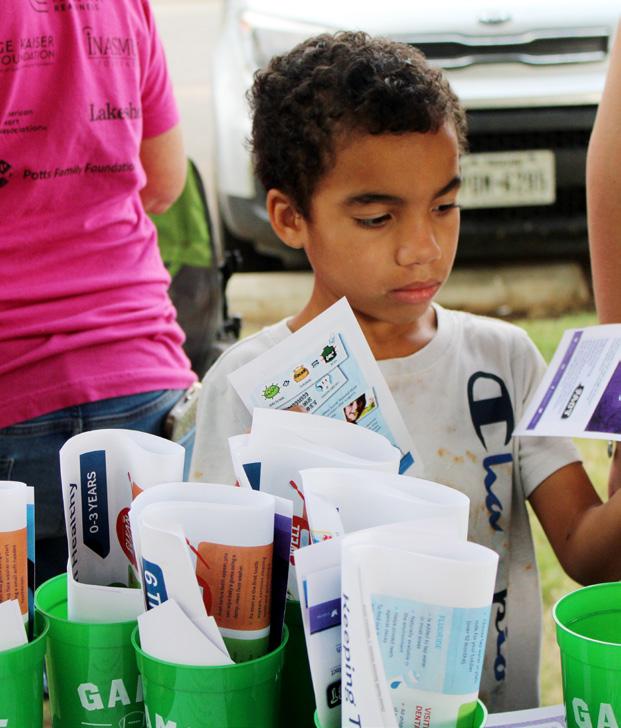
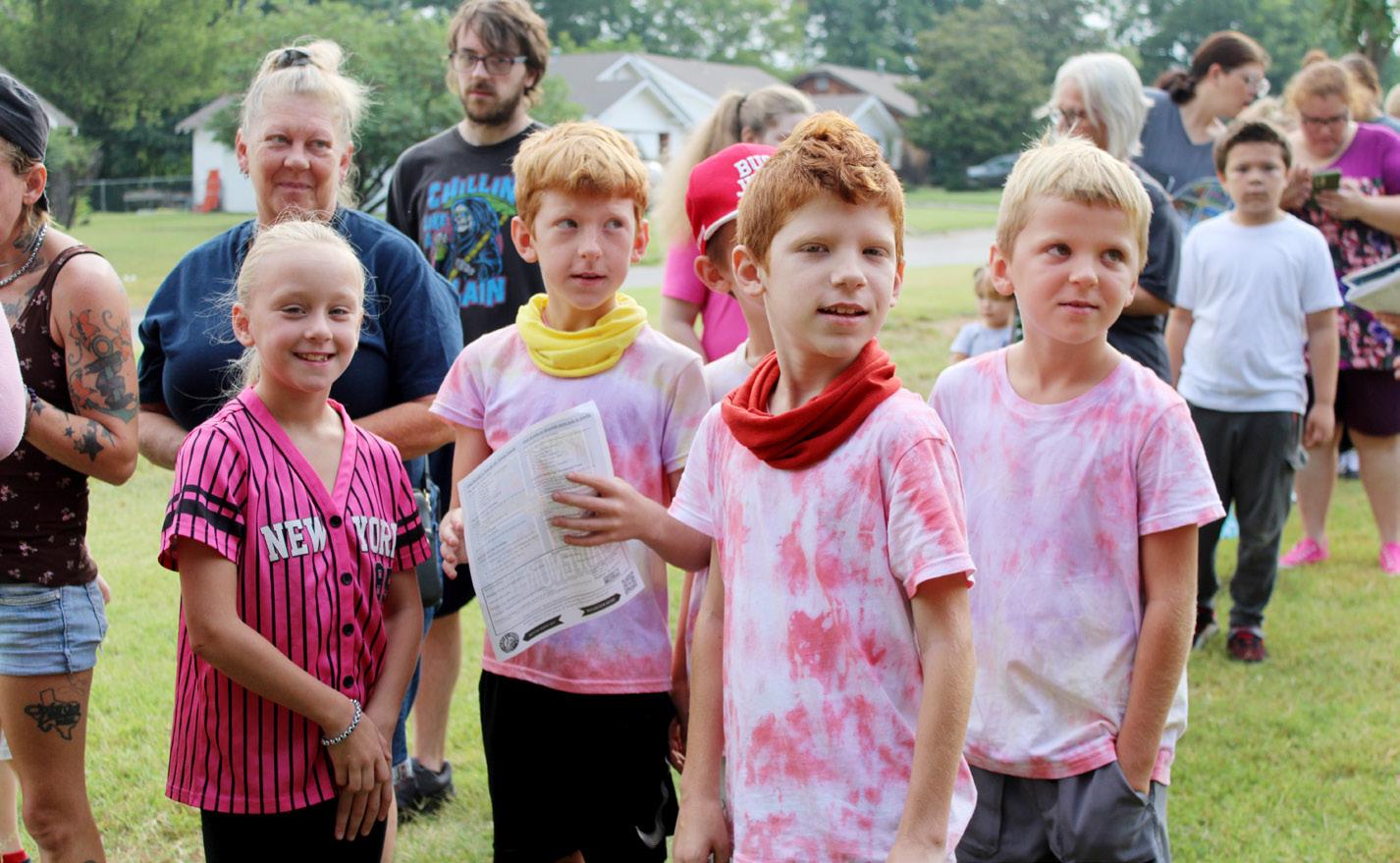

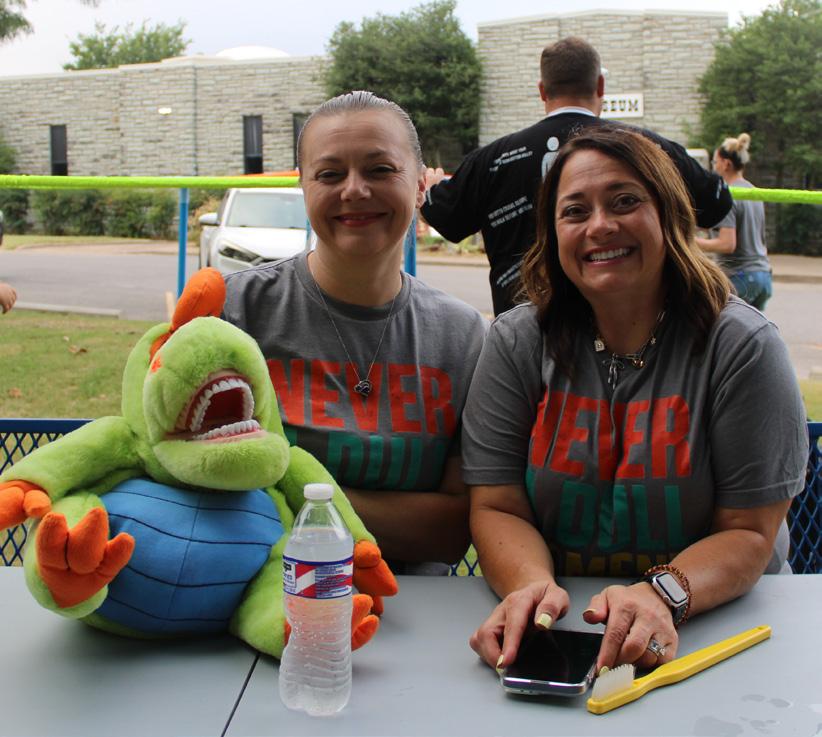

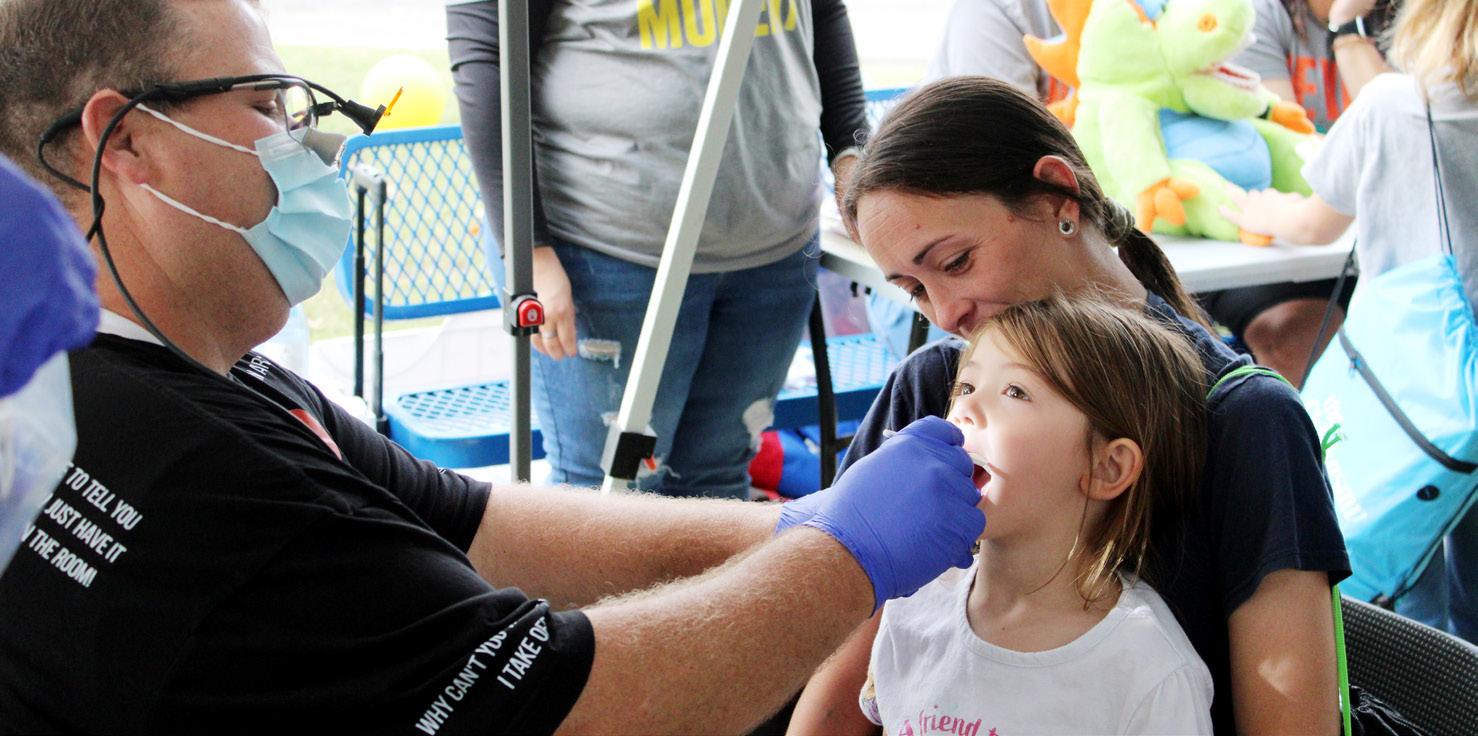
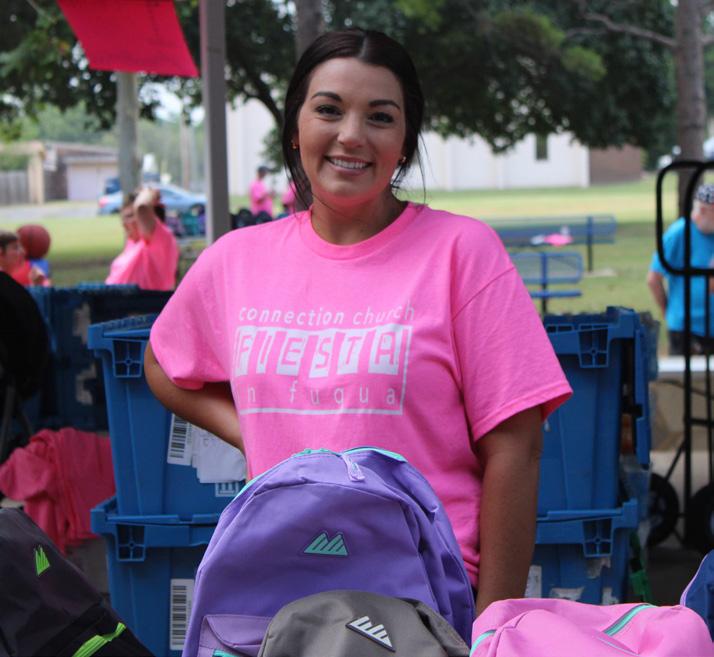
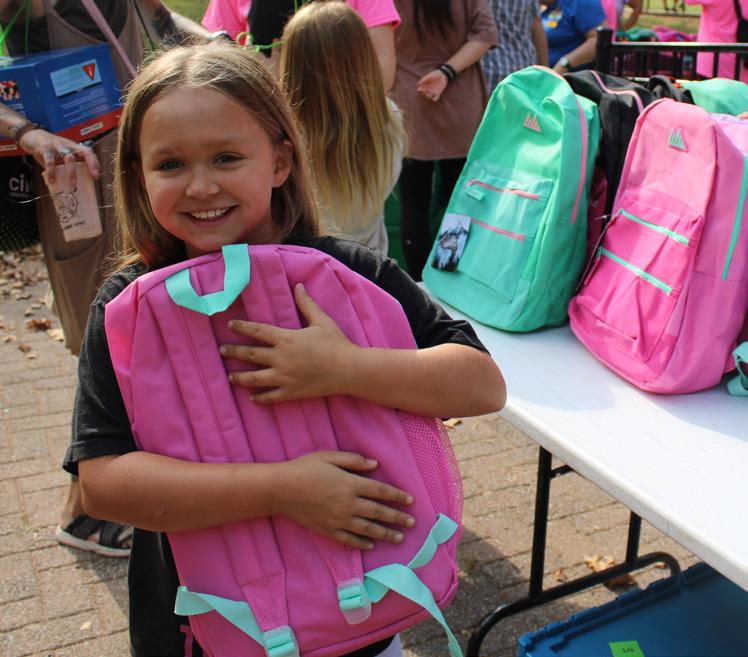
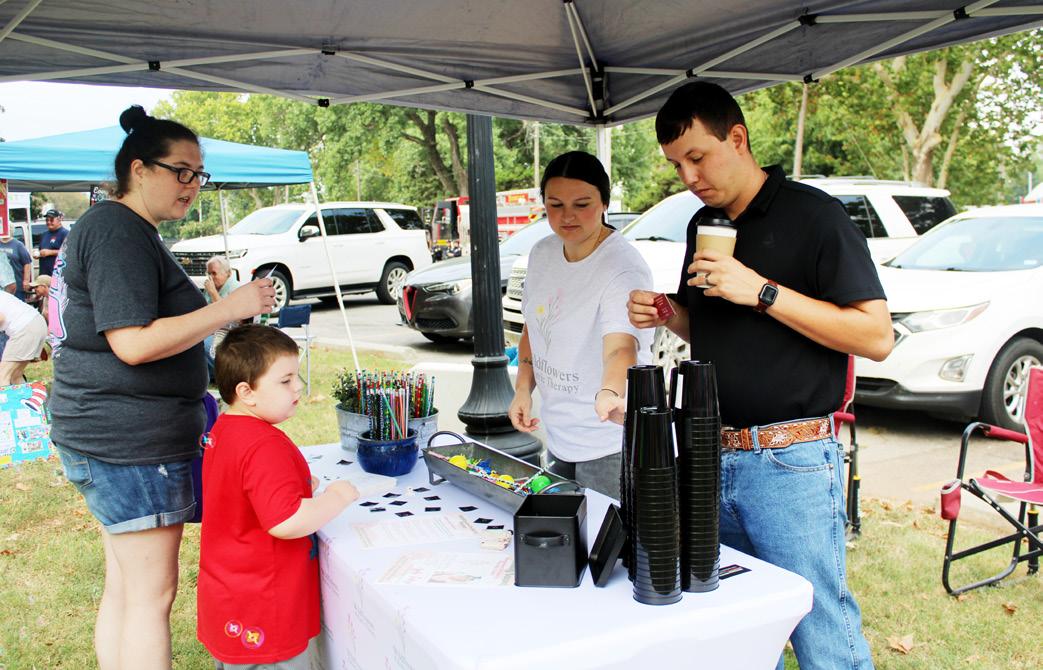
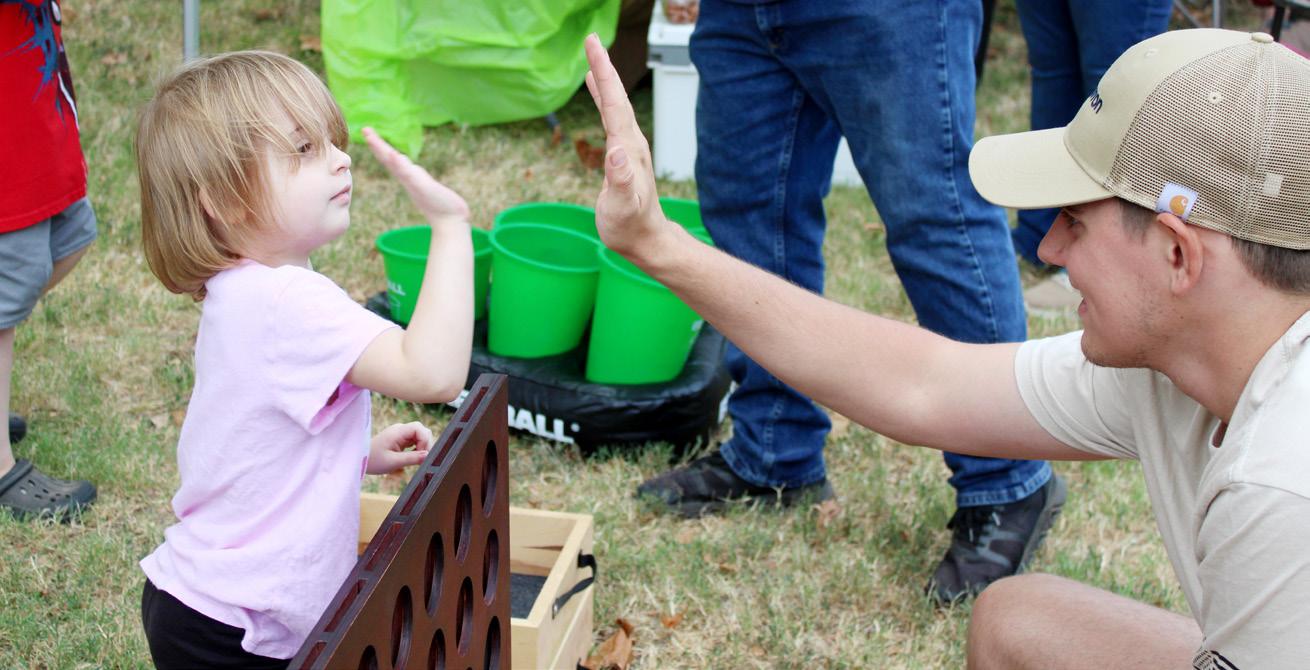
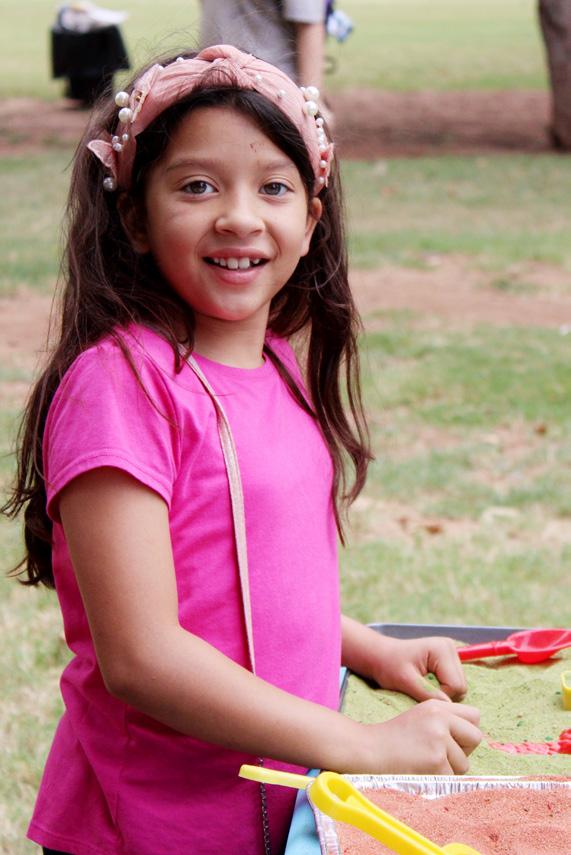








ELK CROSSING NURSING AND REHABILITATION CELEBRATED ITS 10TH ANNIVERSARY THURSDAY, JULY 24. RESIDENTS, PRE-K STUDENTS AND ATTENDEES ALIKE ENJOYED SWEETS TO CELEBRATE THE BIRTHDAY PARTY.
Photos by Toni Hopper

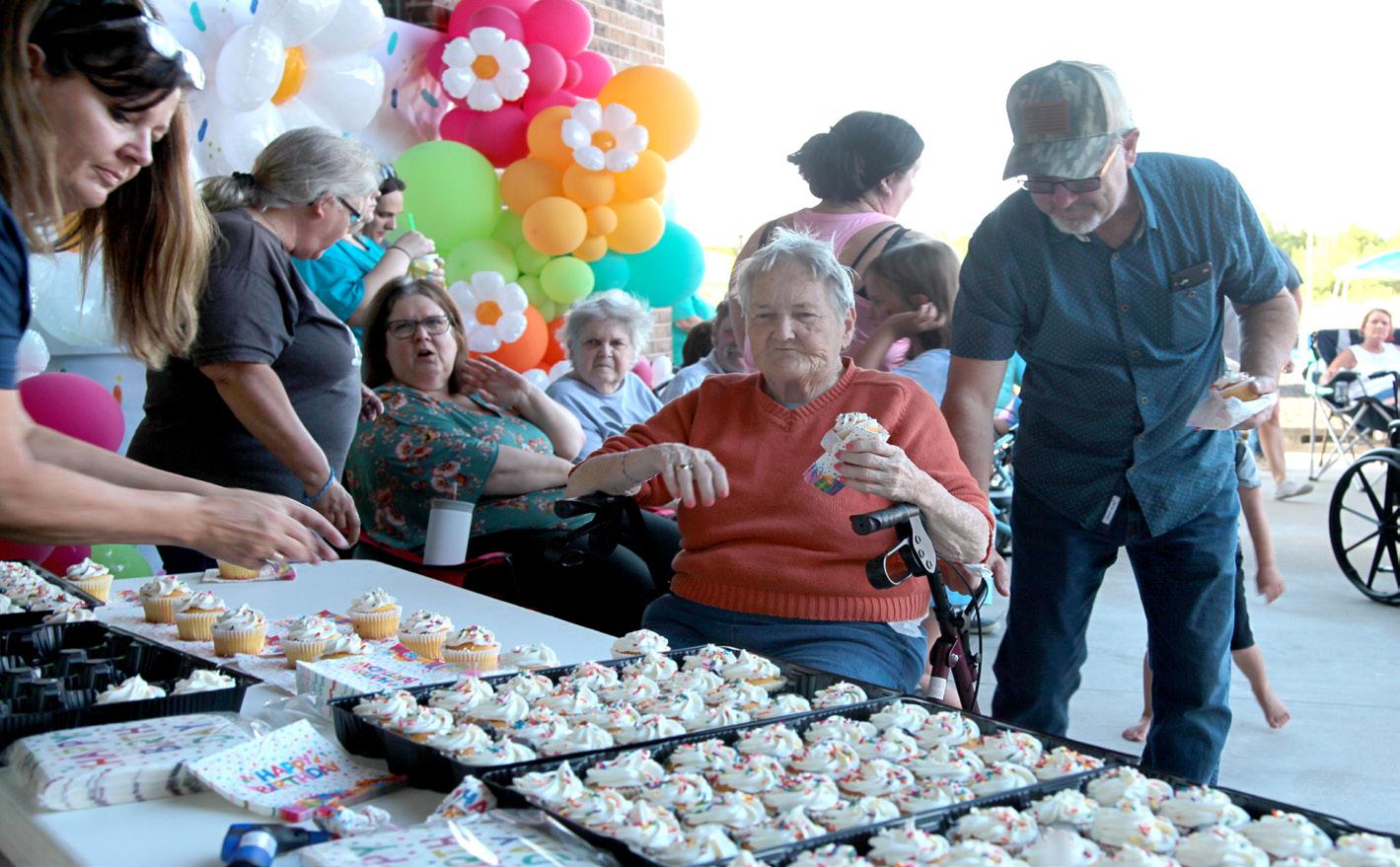



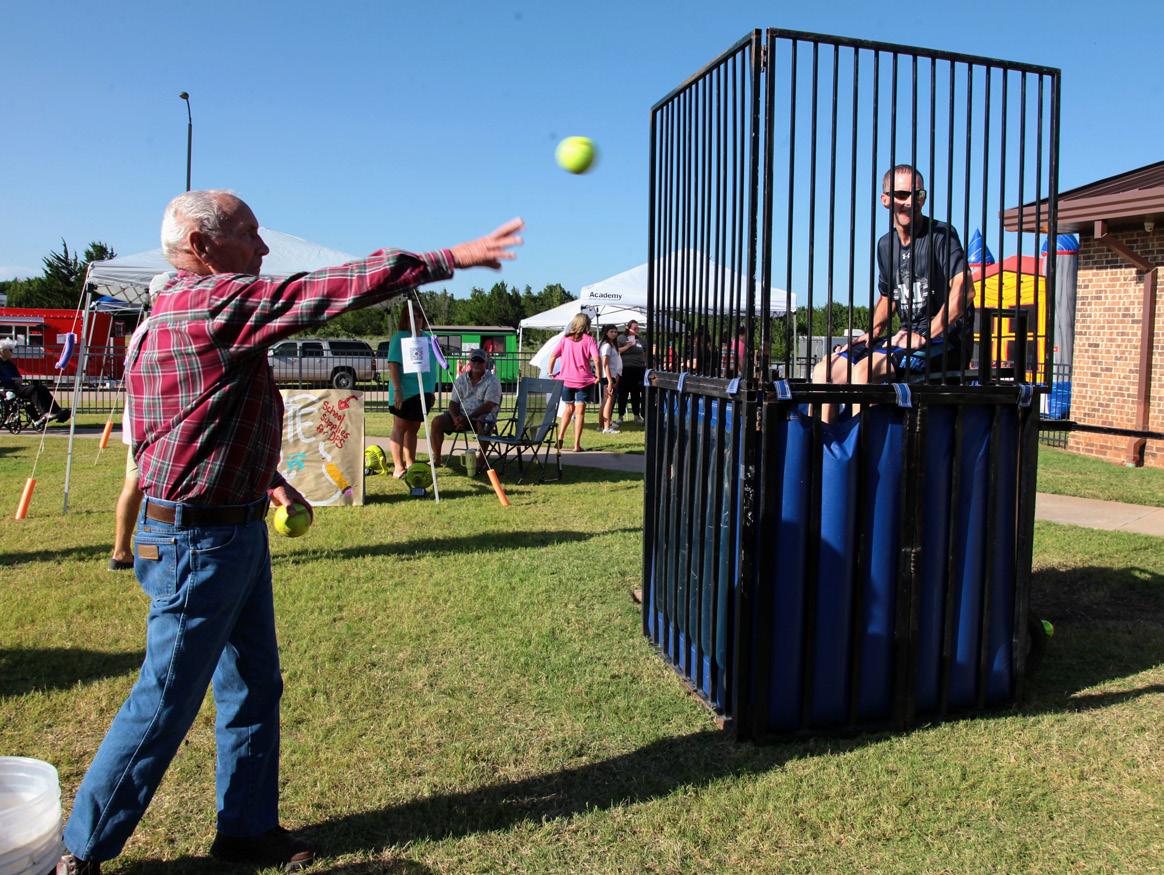






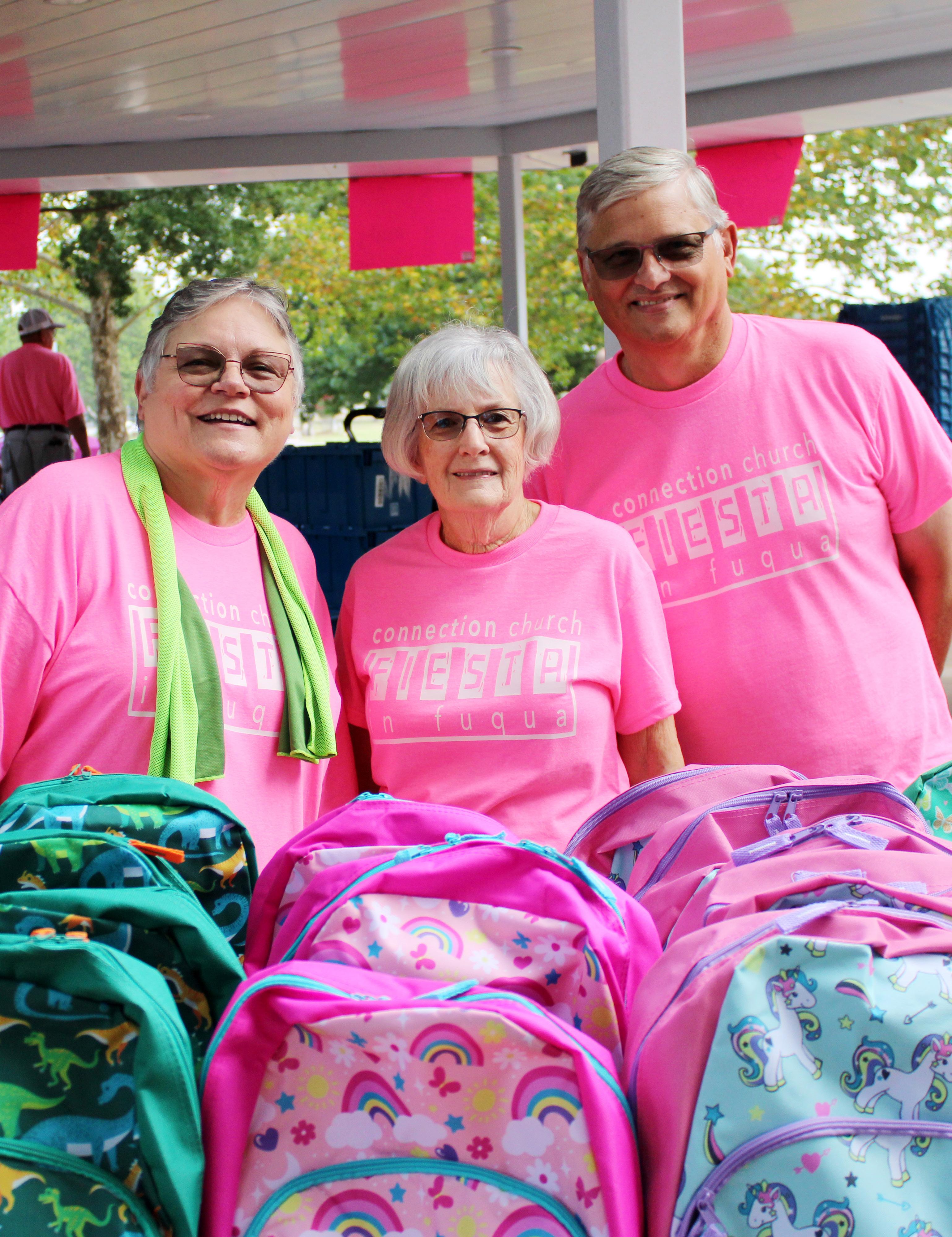
LESLIE MCGUIRE, JANET SHIRLEY AND DANNY MCGUIRE HELP HAND OUT BACKPACKS FILLED WITH SCHOOL SUPPLIES AT THIS YEAR’S FIESTA IN FUQUA.
BY TAMARA GREGOR


